
pjac
-
Posts
183 -
Joined
-
Last visited
Content Type
Profiles
Forums
Blogs
Gallery
Events
Store
Posts posted by pjac
-
-
Kev
These look nice.The cavalry helmet looks like 6th Dragoon Guards (Carabiniers), although I'd expect the star and the central device to be white metal.May just be the photo.Which regiment is the OR line infantry to -can't tell as several have the castle device. Is the RA volunteer an officer's or OR's.Any specific unit name?
Looks like you did well -which auction house was it? I hadn't noticed these anywhere. Are you a long-term helmet/headgear collector?
Just in case you haven't seen it I've got a thread in this section, 'British helmets collection' which you may find interesting.
Patrick
0 -
Patrick, this is based upon my rudimentary (perhaps incomplete) personal observation of Royal Artillery cap badges. I did not intend to imply my impression applies universally to all KC cap badges. I also have not seen it written - even regarding RA badges. I looked in my very basic Wilkinson-Latham reference and did a quick Google search; most references mention simply the scroll varities and the option of spinning or fixed wheel on the gun. Of course, both GV and GVI KC are the "Tudor" crown and differences very well could just be manufacturer dye variations, but my impression is that WWI vintage RA badges have open arcs, while the closed arcs are of later manufacture.
I've posted the question on The British & Commonwealth Military Badge Forum to see how the experts respond.
Rick
Hi Rick
Sorry, I hadn't realised you were talking specifically about RA. However, it's interesting to see the various responses on the topic. That 'Hate belt' posted by Ralph A looks superb!
Patrick
0 -
Thanks both for your comments. I will be leaving well alone!
Patrick
0 -
Kev
If it was the real thing and in good nick, I'd reckon £400- 500 upwards. If I could get it for that, I'd be pleased
Patrick
0 -
Irish Gunner
Re your comment
'This is indeed a WW2 vintage Royal Artillery cap badge. The crown is the key; George VI crown is only slightly different than the WW1 vintage George V crown. The main difference: GVI has closed arcs at the top; GV has open arcs. (QEII also has open arcs, but the arcs are more "heart" shaped.)'
I'd be interested to know where you got this information. I've never heard or read this before and it's not borne out in practice. For example, I have an Army Remount Service badge which has the GRV cypher with closed arcs on the crown and Military Police and Royal Engineer badges with the GRVI cypher and open arcs on the crowns . Also badges to a number of WWII units when the King was George VI which have open arc King's Crowns. I suspect it's more to do with individual manufacturers' dyes.
Patrick
0 -
It looks a nice piece but,as Mervyn says, pictures are needed to judge condition, authenticity and value. Are you buying or selling?
Patrick
0 -
The museum couldn't throw any light on this,other than to speculate that some cleaning process had been used in the past which had altered the white metal. Seems unlikely to me,but.....
Patrick
0 -
Peter
Thanks for your comments. My instinct is not to mess with it, but I'm just testing the art of the possible.
The metal certainly isn't solid brass because, as I mentioned, the back of the plate (which is one piece) is white metal and the metal on the band when the rosettes are removed is white (see not very good photo). This latter point makes me wonder about your idea about brass-plating , I don't know anything about the technique, but why would the metal under the rosette be left un-plated? The same question arises, of course, if it has been painted -why not remove the rosettes and do the job properly? It does, however, look much more like plating than paint, so I think you're on the right lines.
I'll follow up your idea re the museum. David Rowe told me once that Yeomanry helmets can sometimes vary from the 'standard' , according to the whims of the C.O. but I've looked at all my reference books, including his, and I can't find any reference to brass fittings. I've also tried emailing him as he has been very good with advice in the past, but haven't heard anything back as yet. If anybody can cast any light on the question, I'd be very pleased .
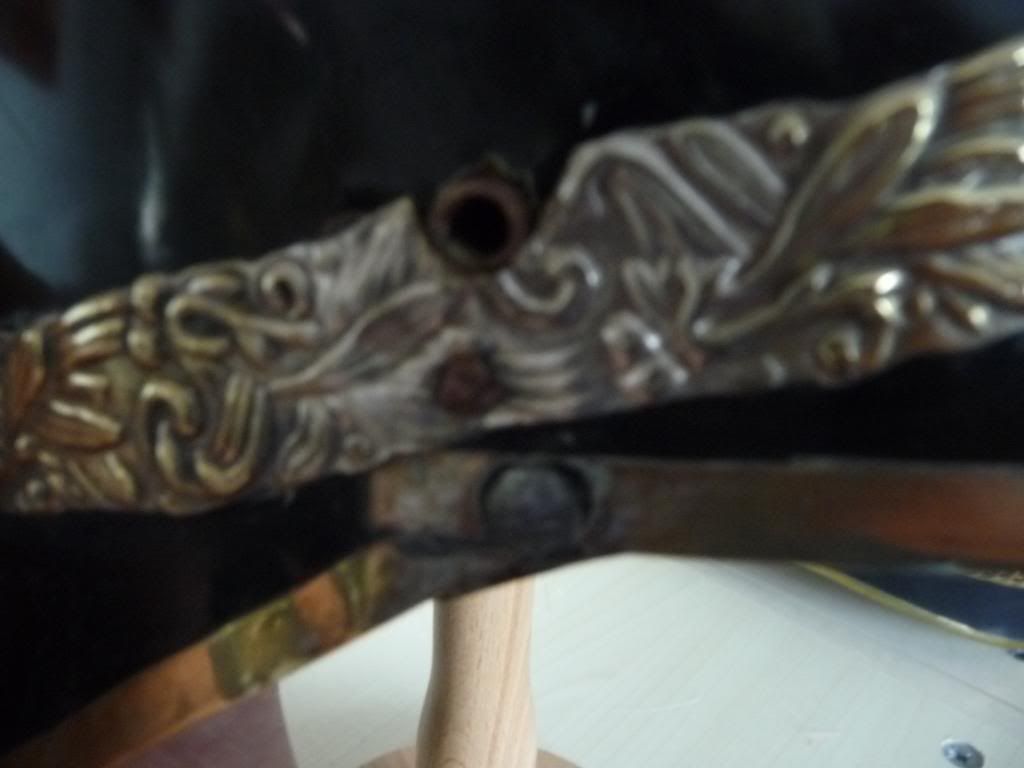
Patrick
0 -
Hi Mervyn
If somebody did paint it for that reason, they don't know their helmets either,as the officer's helmet had silver metal fittings. A mystery!
Patrick
0 -
I thought I'd update this topic for those of you who are into British helmets of this vintage.
1. Staffordshire Yeomanry trooper's Albert pattern helmet
In excellent condition except that the correct white metal fittings appear to have been very carefully painted to resemble brass or gilt - the back of the plate is white metal and the decorative bands under the rosettes are white metal, but otherwise it's not obvious at all .Does anybody know a legitimate reason why a Staffs helmet could have been changed like this? If not, I'm thinking of trying to get it back to the white metal -see post in the 'restoration' thread.
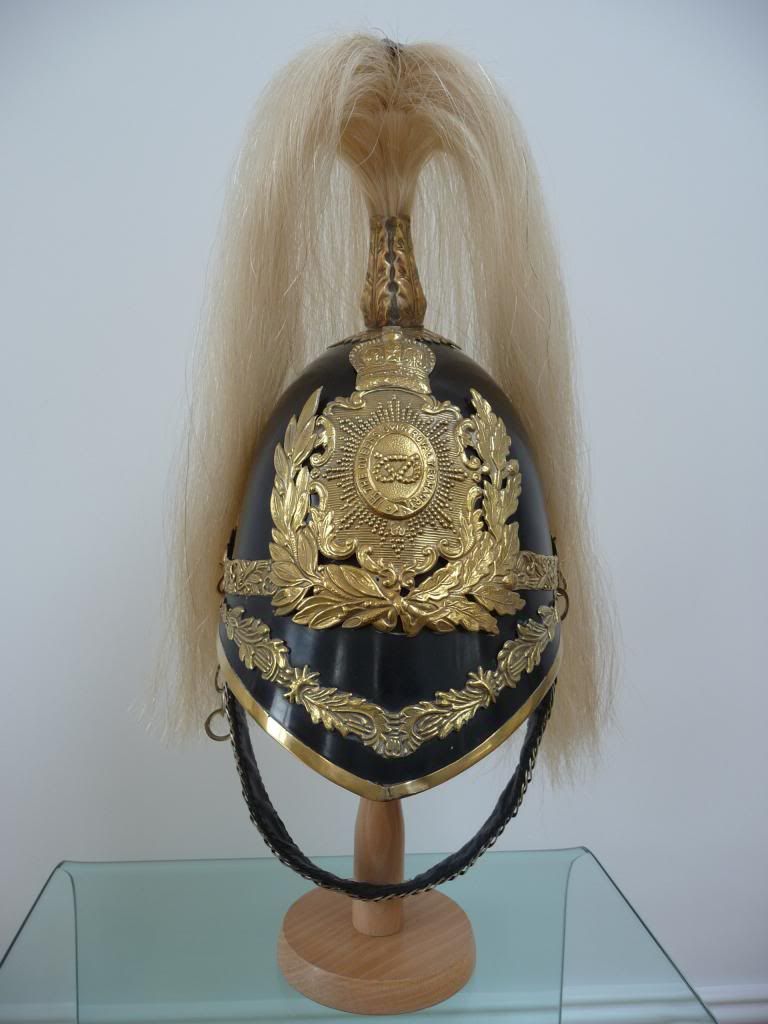
2 Derbyshire Yeomanry Albert pattern trooper's helmet 1864-1871
Good condition, except that this example has white metal rosettes, which should be brass, and it should have a red over white plume. Having said that I felt lucky to find a red plume of the right style which I bought separately
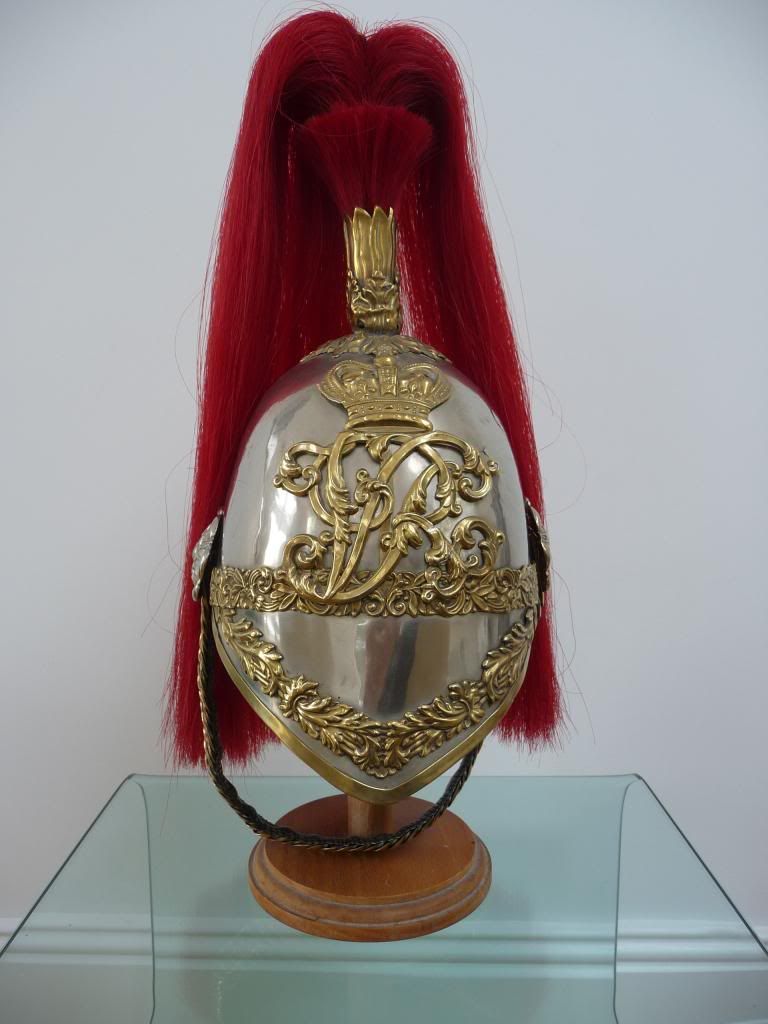
3 QVC West Kent officer's blue cloth/home service helmet
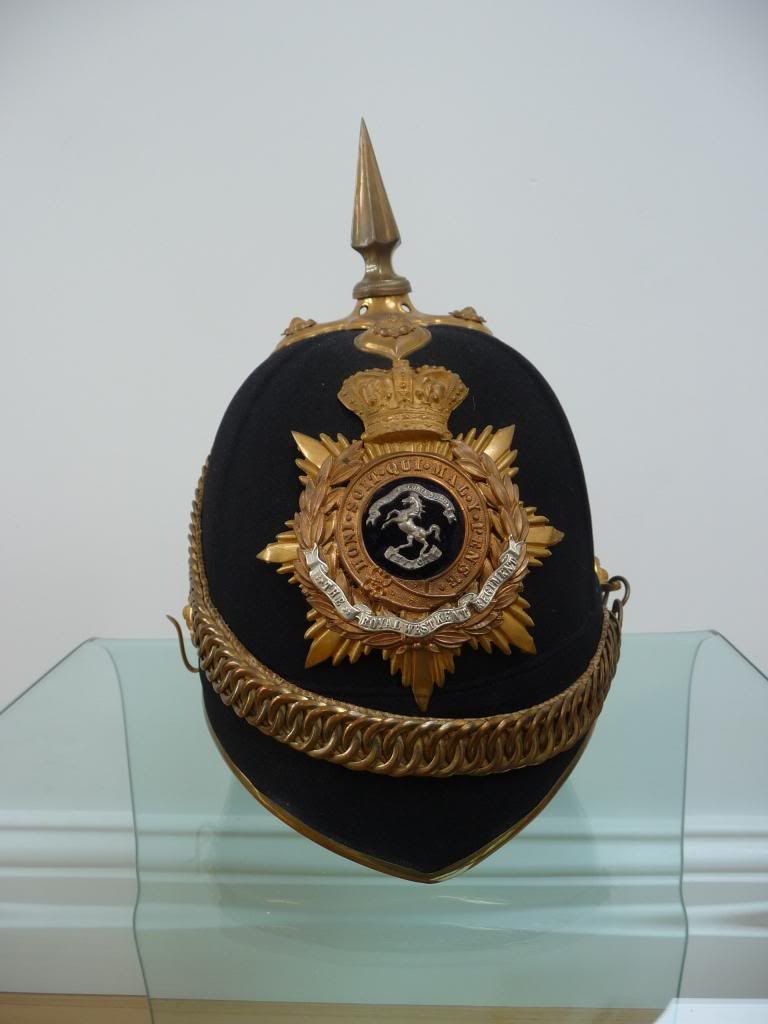
4. QVC Manchester Regiment officer's blue cloth/home service helmet
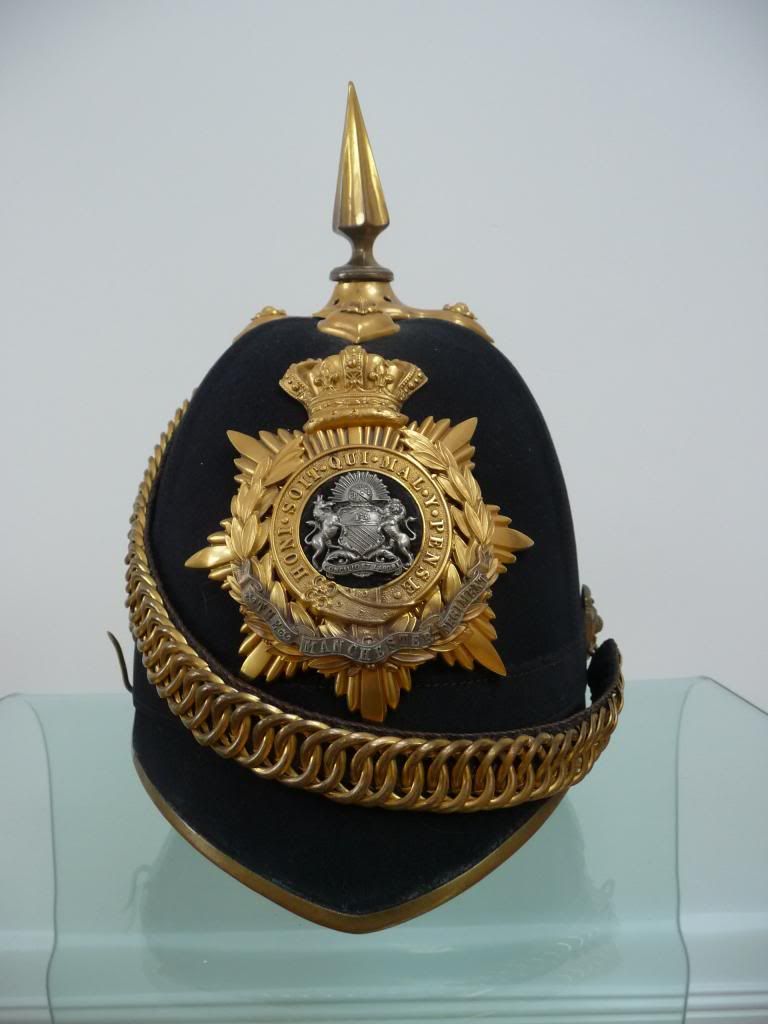
5. KC Royal Engineer's officer's blue cloth/home service helmet
This came with a tin named to A B Clough Royal Engineers and I've started doing some research on him. The helmet had been used as a prop by an Amateur Dramatic group and I got it very cheaply immediately after it appeared on an EBay 'Buy Now' posting - a lucky bit of browsing!
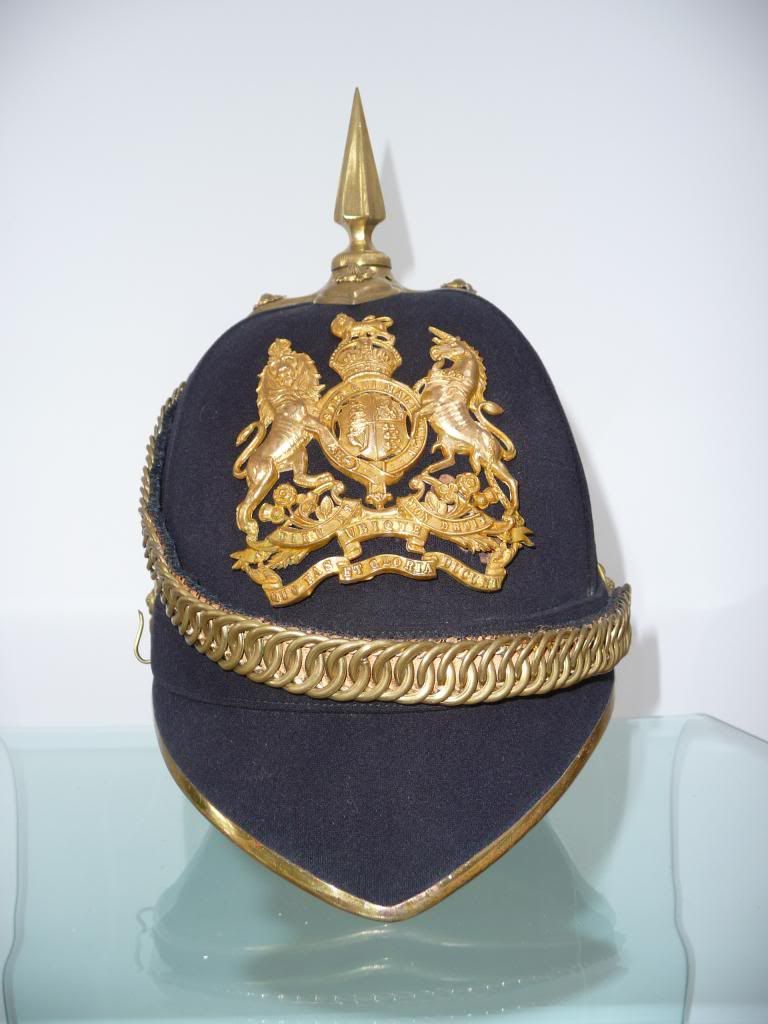
Are there any other British helmet collectors out there,(apart from Stuart who has left this forum) ?
Patrick
0 -
I bought this Staffordshire Yeomanry helmet a while ago on ebay at a good price. It's in excellent condition, except that when I cleaned it up what looked like tarnished white fittings (which would be correct) came up looking like brass. They are not, however, as the back of the helmet plate and the decorative band under the rosettes is white metal. It therefore seems to have been painted but it must have been done exceptionally well as there's no sign of paint on the helmet around the intricate decorative bands which are riveted on, and couldn't have been taken off for painting. I know there are a variety of products which will strip the 'brass' paint, particularly if used with ultra fine steel wool, and I'm wondering about taking the fittings back to the white metal.However, whilst I can remove most of the elements to to do this, I would have to do the decorative bands and peak trim in situ and I'm concerned that anything I do, even very carefully, may also damage the japanning, which I understand is oven heated paint. Can anybody comment or advise?
Better still, does anybody know a legitimate reason why the fittings on a Staffs helmet should have been changed in this way?

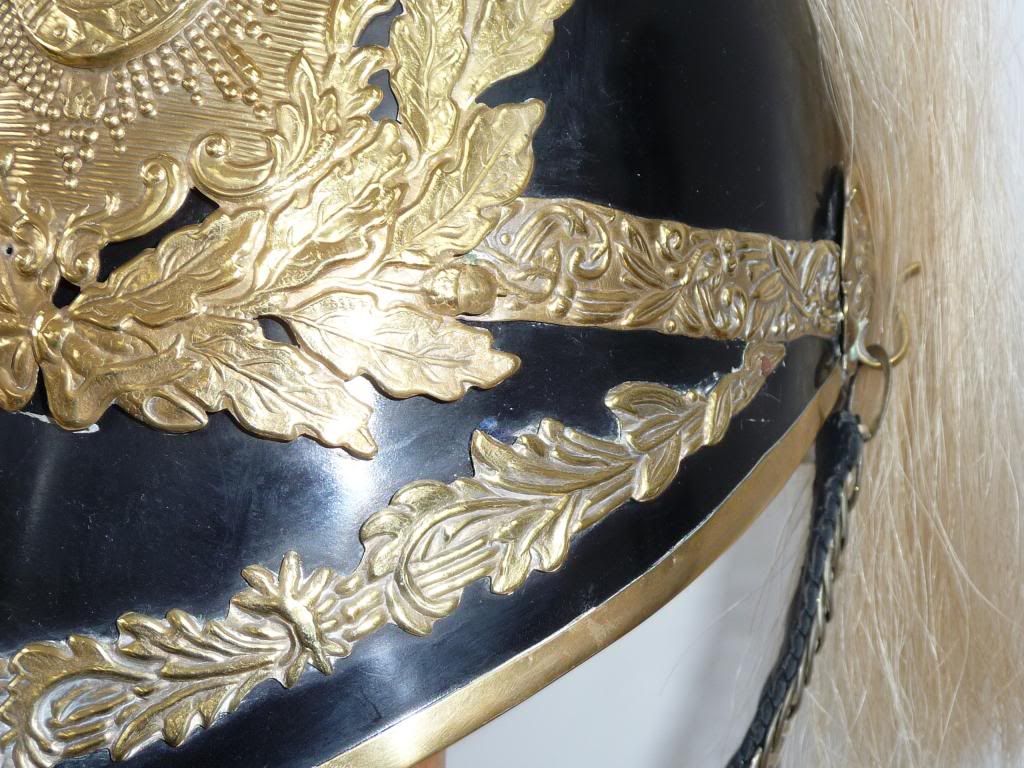
Thanks
Patrick
0 -
Nice helmet. Small point- it's the South Lancashire 'Regiment', rather than 'Rifles'
Patrick
0 -
Just thought I'd add this one. Royal London Militia. The helmet and plate would only have been worn for a very short time as the home service helmet was introduced in 1878 and the the unit ceased to exist in 1881 when it became 4th Battalion Royal Fusiliers.
Patrick
 0
0 -
Thanks, Mervyn. Look forward to hearing if you have anything.
Patrick
0 -
I know there's a sales area on the site, but I can't find anywhere to raise possible exchange of items. so I'm posting here.
I have a Manchester Regt officer's Bluecloth helmet in very good condition, which I'd be willing to put into an exchange or part-exchange deal for other types of officer's headgear . Looking in particular for a visor type forage cap, an 1869 pattern line regt shako , or a Volunteer RA bluecloth. Must be in very good condition. Also willing to consider any other type of Victorian or Edwardian officer's headgear.
The body of the helmet is in perfect condition, and the gilt is still present, being particularly bright still to the plate and rosettes. Still has the velvet backed chin chain and perfect sweat band and silk liner. See photos.There are three neat small slits showing that another plate has been worn, but this is consistent with a QVC plate being carried previously. The reason I'm prepared to let this go is that I have a QVC Manchester's, and I thought I might find one of the things I'm looking for through an exchange, rather than looking to buy.
Please pm me if interested.
Patrick

 0
0 -
Just found this plume - not sure what the 'not guaranteed' bit means! http://www.blunderbuss-antiques.co.uk/viewphoto.php?shoph=29504&phqu=3
0 -
The book I recommend is 'Head Dress of the British Heavy Cavalry', by David Rowe. Published by Schiffer Military History. You often see it on us ebay, and I think I got mine from Amazon. Great photos and illustrations and a lots of information - a quality item. This is an 1871 trooper's helmet to 5th Dragoon Guards. The plate and liner are those of a trooper's, not an officer's helmet. Mervyn is right that it should have a plume holder, with a white over red plume. It should be a brass helmet, with the plate, as this one has, having a white star and numeral and the garter surrounding the numeral in brass. I knew somebody a few years ago who made me a couple of plumes. I don't know if he's still active and I don't want to put his name in the posting, so send me a pm and I'll give you the details.
Mine is below
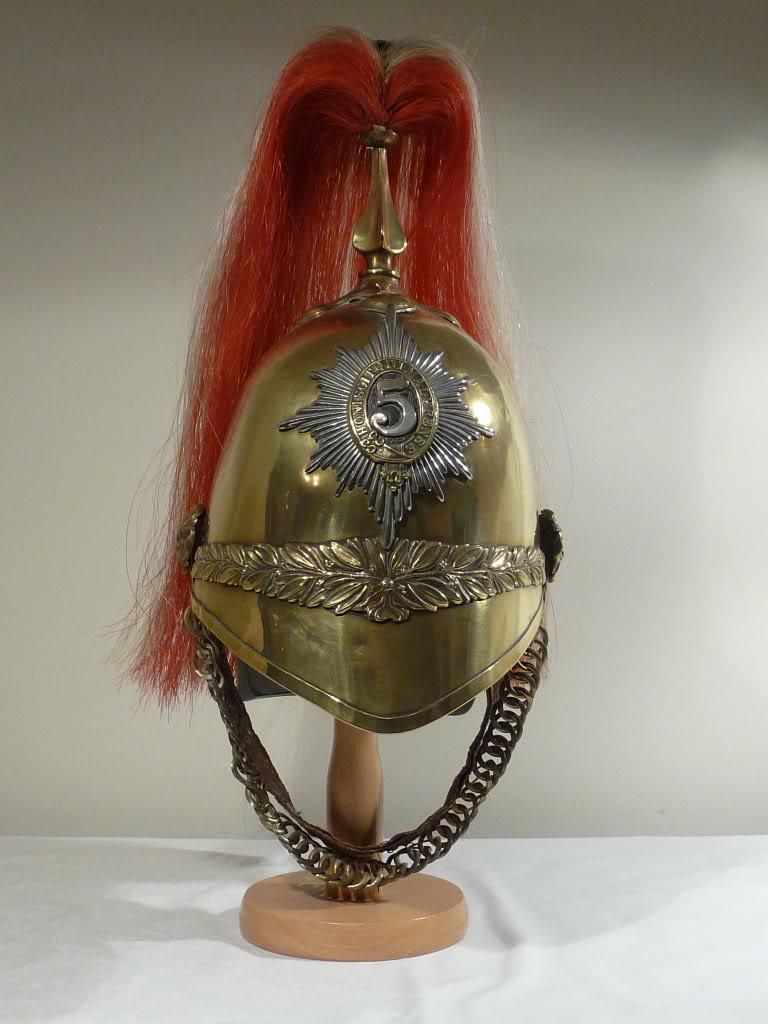
Patrick
0 -
Maxime
This is a superb collection.Are you a member of pickelhaubes.com? If not, you should be.
Patrick
0 -
A great display. Fascinating.
Thanks
Patrick
0 -
Since they didn't have proper weapons initially, that would have been a sensible policy anyway, if confronted by German paratroopers!
Patrick
0 -
Sorting out my late father's effects recently, I came across a khaki armband with 'LDV' printed in black and a smaller capital 'A' in red . Does anybody know what the A signifies?
There were also a number of documents relating to 41st County of Lancaster Battalion Home Guard - mainly relating to 'stand down ' in December 1944.
Dad was an industrial chemist with ICI before the war and although he'd been in the OTC at Queen's, Belfast, he was not allowed to join up, but had to join the LDV/Home Guard. His company, ' C', was, I think, based at Prestwich and included a number of men, who, like Dad, worked at ICI in Blackley , North Manchester.
I presume there are LDV/Home Guard collectors?
Patrick
0 -
Sorting out my late father's papers recently, I came across a couple of WW1 trench maps. The first, ' France sheet 36 N.W.' scale 1:20,000, is centred on Armentieres and shows the trench systems to the east and south of there as at 24 September 1917 . The second, 'France Sheet 51B S.W.', same scale, shows a number of small towns e.g. Mercatel, in the British lines, and Croisilles in the German lines - many more trenches and much more complex systems than on the first. Shows the situation as at 27 July 1918.
I know nothing about these sort of maps. Are they collected?
Patrick
0 -
Superb items-thanks for posting.
I can see why Stuart covets the cap!
Patrick
0 -
I worked in Grangemouth for many years, so this medal has particular interest.Thanks for posting it.
Patrick
0


Battle of the Badges
in Great Britain: Militaria: Badges, Uniforms & Equipment
Posted · Edited by pjac
Ralph
I'm not sure what you're looking for, but here's a very quick snapshot of my badges. Lighting's poor, I know.
Left to the right, top- Primarily London Regt; Yeomanry; WW1 raised units, economy versions and WW1 version of badges which changed later; Cavalry
Left to Right bottom- A mixture;Scottish and some guards and volunteers; and then two frames of line infantry
What are you wanting- favourite badges, rare badges?
Patrick